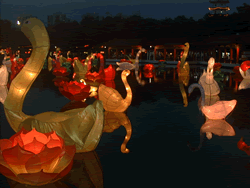 |
Lantern
festival, Singapore © George P Landau |
Teng Chieh, the Lantern Festival, occurs on the night of the full moon and closes out the Chinese New Year observances. It began as a religious ritual nearly 2,000 years ago during the Han Dynasty (206 BCE—221 CE). Since then, fireworks and riddle-guessing contests have been added to the festivities.
A wondrous source of light, the lantern is a traditional symbol of the lengthening days of spring. Lanterns in the shapes of dragons, birds or other animals are hung in streets, placed in parks and outside temples and around homes. Auspicious phrases are often written on them to ward off evil spirits. Some decorate their lantern with a riddle, offering a prize to the first person who solves it.
The light given off by the lanterns is said both to attract heavenly spirits and allow the living to observe them. Celebrations include fireworks, folk dancing, and performances such as the dragon parade and lion dance. The special food associated with the festival is yuanxiao, a round, stuffed dumpling made with sticky rice flour that symbolizes family unity, completeness and happiness.